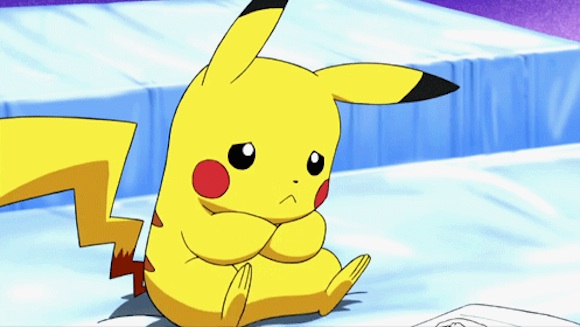
Pokémon is a long-running global megalith: a multi-platform media franchise like no other. Millions of kids grew up watching the anime, wearing the T-shirt, and of course playing the games. Here in Japan, Pokémon characters are everywhere – and none more so than Pikachu. Go to the mall and there’s a giant fluffy Pikachu to meet and cuddle. At school lunch, chances are a bunch of kids’ mums have made their onigiri into Pikachu’s face for them. And a whole city was recently invaded by scores of our favourite yellow friend for an entire Pikachu festival.
There’s a new kid on the “collect-all-the-monsters” block, though, and it looks to be pushing Pokémon by the wayside. Yo-kai Watch hasn’t been released internationally yet, but in Japan the 3DS game, anime and its characters have quickly gained a ubiquitous popularity that looks like it could even overtake Pokémon. Have Pikachu and friends really had their day? Or is Yo-kai Watch merely a flash in the pan?
▼ Yo-kai Watch‘s hero Keita, pictured with yōkai and his rad-cool watch tool.
On paper, Yo-kai Watch is a classic monster-hunting game in the Pokémon mould: a role-playing game in which the player searches around town for yōkai (“monsters”, roughly) to catch and battle with. The first game, from independent Level-5, was released last year, and the sequel Yo-kai Watch 2: Ganso/Honke followed on July 10, 2014. Each has shifted over a million copies (in Japan alone, remember!), with Yokai Watch 2 selling 1.3 million in its first four days of release.
There’s also a TV anime series that’s been showing since January, and a movie out at the end of this year. And, just like Pokémon has done so successfully before, along with the game and animated media comes the merchandise. One toy in particular – the now impossible-to-find Yo-kai Watch that gives the franchise its name – has caused huge lines to form outside stores – just to enter a draw for the chance of buying one.
▼ Lines”R”Us.
@dancingrainer, via Naver Matome
The cute and popular Yo-kai Watch character vying for Pikachu’s crown is ghost cat Jibanyan, who can now be found on lunch packs, candy boxes, and of course at meet-and-greets in shopping malls around Japan. When one mall booked Pikachu and Jibanyan to appear at the same time on the same day, the difference in numbers was stark, as this Twitter user reported:
“You can just go up and touch Pikachu, but Jibanyan [is so popular he] needs his own queueing and ticketing system.”
@hakata_red, via Naver Matome
So it looks like Pokémon’s popularity is waning. But why? Well, I can’t help but wonder if liking Pokémon in Japan has become a bit like liking The Simpsons is – or rather was – for me growing up in the UK.
I’ve never met anyone who says they don’t like The Simpsons. Everyone likes it. In middle school I had a Simpsons family poster on my bedroom wall, and my teacher had the same poster by the blackboard in our classroom. And yet I’ve never met anyone who’d actively call themselves a Simpsons fan either, or say it was their favourite programme. The Simpsons just is. Its characters and gags are a part of the cultural backdrop – a reference point that’s commonly understood and – don’t get me wrong – amazingly, enduringly popular, but not one that kids get terribly excited about.
▼ Even in Springfield, the line for Yo-kai Watches was unbearable.
But how will Yo-kai Watch fare with an international audience? Unlike Pokémon‘s “it-could-be-anywhere” world, Yo-kai Watch is firmly set in Japan, with yōkai drawn from Japanese folklore. On the one hand, this will earn it bonus interest points from Japanophiles around the world. But the show’s Japanese-ness could also be a potential barrier to mass-market success. Yo-kai Watch isn’t available to play or watch in English, yet – but when it is, will its location be changed to America, as was done for the recent launch of Doraemon on US television?
▼ “It’s dorayaki, I swear! It just looks like pizza…!”
The sweeping changes made to Doraemon for an English-speaking audience were met with criticism, but did bring the issue of localisation briefly to the fore. Replacing chopsticks with forks and Japanese food with pancakes, as was done in the Doraemon release, gets fans of the original show hot under the collar, but it does achieve the main objective of localisation:
“The idea is for content to ‘feel’ the same in the target language as it did in its native language.”
(Matt Alt, interviewed at Tofugu.com)
The world of a game, therefore, should feel as familiarly understandable (and as magical and mysterious) to a kid playing in English as it does to a Japanese child playing the original. If Yo-kai Watch‘s makers pull off its translation and localisation without any hitches, it has the potential to succeed Pokémon as a long-standing hit.
There’s one other problem Pokémon is facing that Yo-kai Watch won’t escape either, if it sticks around long enough: ageing fans. Pokémon Red and Green launched in 1996, so those kids who first grew up playing it are in their 20s and 30s, now, and have become, as one millennial kid put it, “annoying adult Pokémon fans” who get in the way and make the brand seem a bit less cool. Right now, however, Yo-kai Watch is just loved by kids. It doesn’t have hoards of adult gamer fans…although that’s probably only a matter of time.
Top image: pokeballl/tumblr
Featured image: destructoid